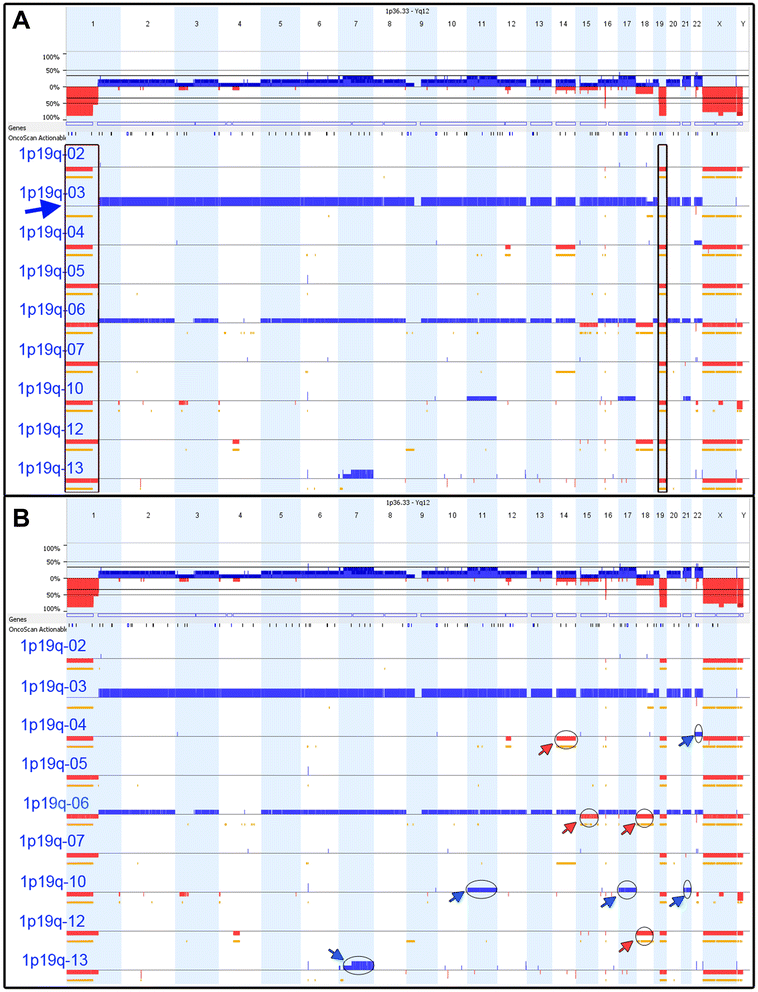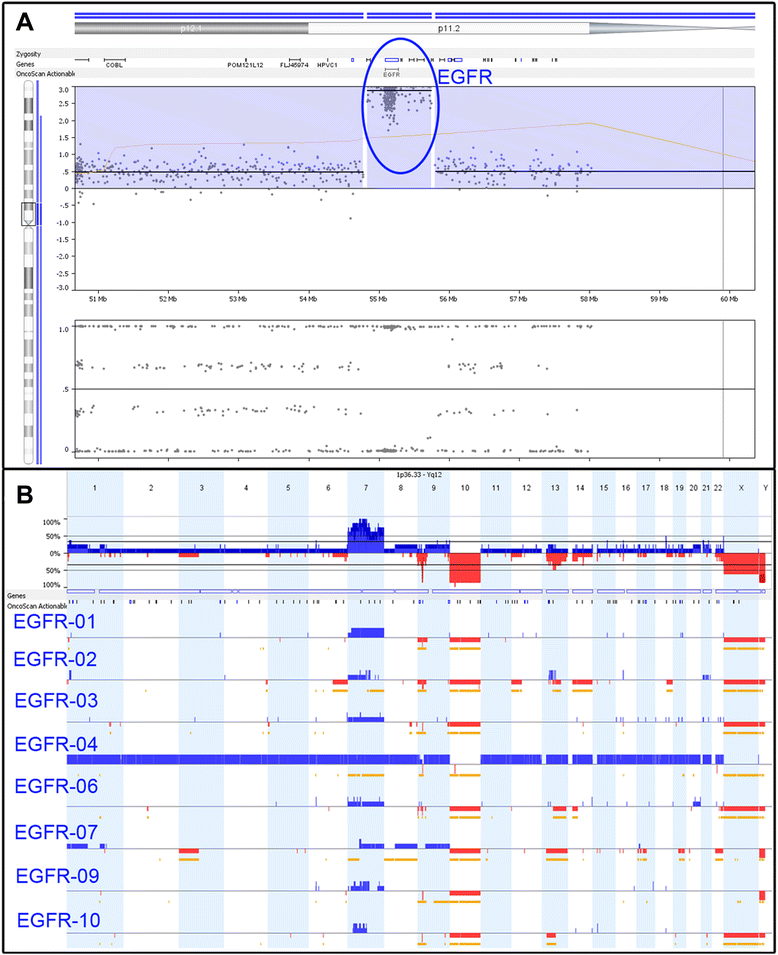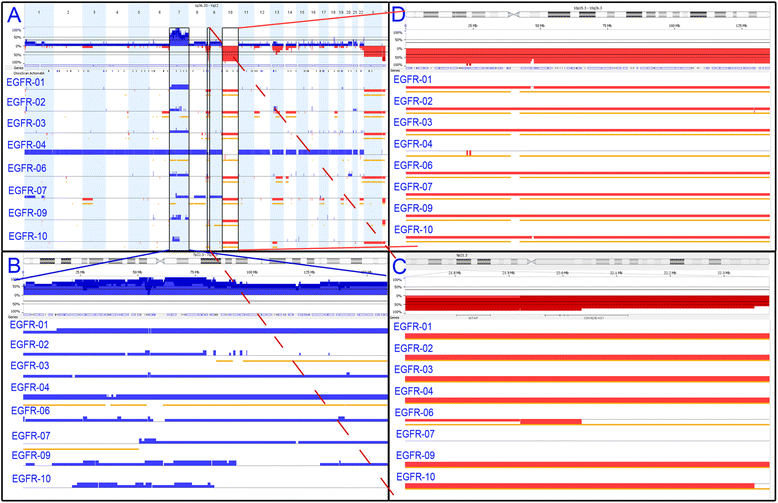Observations of the genomic landscape beyond 1p19q deletions and EGFR amplification in glioma
- PMID: 26257825
- PMCID: PMC4528708
- DOI: 10.1186/s13039-015-0156-1
Observations of the genomic landscape beyond 1p19q deletions and EGFR amplification in glioma
Abstract
Background: With recent advancements in molecular techniques, the opportunities to gather whole genome information have increased, even in degraded samples such as FFPE tissues. As a result, a broader view of the genomic landscape of solid tumors may be explored. Whole genome copy number and loss of heterozygosity patterns can advance our understanding of mechanisms and complexity of various tumors.
Results: Genome-wide alterations involving copy number changes and loss of heterozygosity were identified in 17 glioma samples with positive FISH results for 1p19q co-deletions (n = 9) or EGFR amplification (n = 8). Gliomas positive for 1p19q co-deletions did not have other frequently recurrent genomic alterations. Additional copy-number alterations were observed in individual cases, and consisted primarily of large-scale changes, including gains or losses of entire chromosomes. The genomic architecture of EGFR amplified gliomas was much more complex, with a high number of gains and losses across the genome. Recurrent alterations in EGFR amplified gliomas were both focal, such as CDKN2A homozygous deletions, and large, such as chromosome 10 loss.
Conclusions: Microarray enabled a broader picture of the genomic alterations occurring in glioma cases. Gliomas with 1p19q co-deletion had a relatively quiet genome, apart from the selected co-deletion. Additional alterations in isolated cases, involved primarily larger aberrations. On the other hand, EGFR amplified cases tended to be more complex and have specific abnormalities associated with the EGFR amplification. Furthermore, 1p19q co-deletions and EGFR amplification associated copy number changes appeared to often be mutually exclusive.
Keywords: Copy number change; FFPE array; Genomic landscape; Glioma; Microarray; OncoScan.
Figures



Similar articles
-
Recurrent copy number alterations in low-grade and anaplastic pleomorphic xanthoastrocytoma with and without BRAF V600E mutation.Brain Pathol. 2018 Mar;28(2):172-182. doi: 10.1111/bpa.12495. Epub 2017 Apr 2. Brain Pathol. 2018. PMID: 28181325 Free PMC article.
-
Rarity of PTEN deletions and EGFR amplification in malignant gliomas of childhood: results from the Children's Cancer Group 945 cohort.J Neurosurg. 2006 Nov;105(5 Suppl):418-24. doi: 10.3171/ped.2006.105.5.418. J Neurosurg. 2006. PMID: 17328268
-
Systematically characterize the clinical and biological significances of 1p19q genes in 1p/19q non-codeletion glioma.Carcinogenesis. 2019 Oct 16;40(10):1229-1239. doi: 10.1093/carcin/bgz102. Carcinogenesis. 2019. PMID: 31157866
-
[Histological and molecular classification of gliomas].Rev Neurol (Paris). 2008 Jun-Jul;164(6-7):505-15. doi: 10.1016/j.neurol.2008.03.011. Epub 2008 Jun 10. Rev Neurol (Paris). 2008. PMID: 18565348 Review. French.
-
Histomolecular classification of adult diffuse gliomas: the diagnostic value of immunohistochemical markers.Rev Neurol (Paris). 2011 Oct;167(10):683-90. doi: 10.1016/j.neurol.2011.07.006. Epub 2011 Sep 1. Rev Neurol (Paris). 2011. PMID: 21889777 Review.
Cited by
-
Prediction of early-stage hepatocellular carcinoma using OncoScan chromosomal copy number aberration data.World J Gastroenterol. 2017 Nov 28;23(44):7818-7829. doi: 10.3748/wjg.v23.i44.7818. World J Gastroenterol. 2017. PMID: 29209123 Free PMC article.
-
Diagnostic test accuracy and cost-effectiveness of tests for codeletion of chromosomal arms 1p and 19q in people with glioma.Cochrane Database Syst Rev. 2022 Mar 2;3(3):CD013387. doi: 10.1002/14651858.CD013387.pub2. Cochrane Database Syst Rev. 2022. PMID: 35233774 Free PMC article.
-
Progression inference for somatic mutations in cancer.Heliyon. 2017 Apr 11;3(4):e00277. doi: 10.1016/j.heliyon.2017.e00277. eCollection 2017 Apr. Heliyon. 2017. PMID: 28492066 Free PMC article.
-
Use of Fluorescence In Situ Hybridization (FISH) in Diagnosis and Tailored Therapies in Solid Tumors.Molecules. 2020 Apr 17;25(8):1864. doi: 10.3390/molecules25081864. Molecules. 2020. PMID: 32316657 Free PMC article. Review.
References
LinkOut - more resources
Full Text Sources
Other Literature Sources
Research Materials
Miscellaneous

